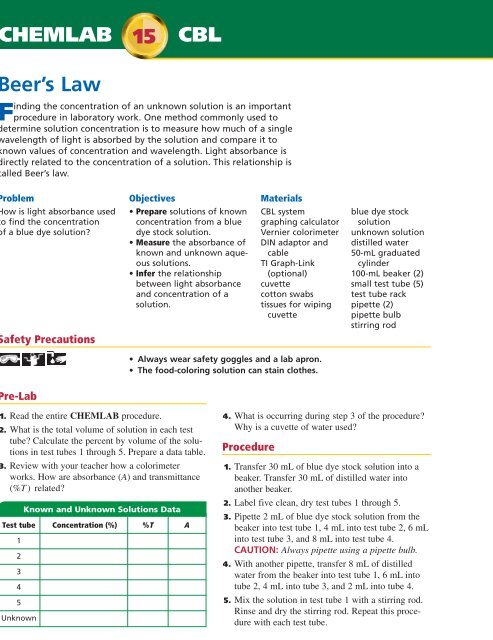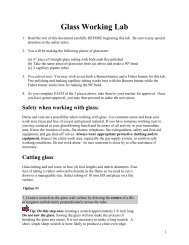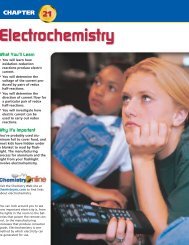Chapter 15: Solutions - Weironline.net
Chapter 15: Solutions - Weironline.net
Chapter 15: Solutions - Weironline.net
Create successful ePaper yourself
Turn your PDF publications into a flip-book with our unique Google optimized e-Paper software.
CHEMLAB CBL<br />
<strong>15</strong><br />
Beer’s Law<br />
Finding the concentration of an unknown solution is an important<br />
procedure in laboratory work. One method commonly used to<br />
determine solution concentration is to measure how much of a single<br />
wavelength of light is absorbed by the solution and compare it to<br />
known values of concentration and wavelength. Light absorbance is<br />
directly related to the concentration of a solution. This relationship is<br />
called Beer’s law.<br />
Problem<br />
How is light absorbance used<br />
to find the concentration<br />
of a blue dye solution?<br />
Safety Precautions<br />
Pre-Lab<br />
1. Read the entire CHEMLAB procedure.<br />
2. What is the total volume of solution in each test<br />
tube? Calculate the percent by volume of the solutions<br />
in test tubes 1 through 5. Prepare a data table.<br />
3. Review with your teacher how a colorimeter<br />
works. How are absorbance (A) and transmittance<br />
(%T )related?<br />
Known and Unknown <strong>Solutions</strong> Data<br />
480 <strong>Chapter</strong> <strong>15</strong> <strong>Solutions</strong><br />
Objectives<br />
•Prepare solutions of known<br />
concentration from a blue<br />
dye stock solution.<br />
•Measure the absorbance of<br />
known and unknown aqueous<br />
solutions.<br />
•Infer the relationship<br />
between light absorbance<br />
and concentration of a<br />
solution.<br />
Test tube Concentration (%) %T A<br />
1<br />
2<br />
3<br />
4<br />
5<br />
Unknown<br />
•Always wear safety goggles and a lab apron.<br />
• The food-coloring solution can stain clothes.<br />
4. What is occurring during step 3 of the procedure?<br />
Why is a cuvette of water used?<br />
Procedure<br />
Materials<br />
CBL system<br />
graphing calculator<br />
Vernier colorimeter<br />
DIN adaptor and<br />
cable<br />
TI Graph-Link<br />
(optional)<br />
cuvette<br />
cotton swabs<br />
tissues for wiping<br />
cuvette<br />
blue dye stock<br />
solution<br />
unknown solution<br />
distilled water<br />
50-mL graduated<br />
cylinder<br />
100-mL beaker (2)<br />
small test tube (5)<br />
test tube rack<br />
pipette (2)<br />
pipette bulb<br />
stirring rod<br />
1. Transfer 30 mL of blue dye stock solution into a<br />
beaker. Transfer 30 mL of distilled water into<br />
another beaker.<br />
2. Label five clean, dry test tubes 1 through 5.<br />
3. Pipette 2 mL of blue dye stock solution from the<br />
beaker into test tube 1, 4 mL into test tube 2, 6 mL<br />
into test tube 3, and 8 mL into test tube 4.<br />
CAUTION: Always pipette using a pipette bulb.<br />
4. With another pipette, transfer 8 mL of distilled<br />
water from the beaker into test tube 1, 6 mL into<br />
tube 2, 4 mL into tube 3, and 2 mL into tube 4.<br />
5. Mix the solution in test tube 1 with a stirring rod.<br />
Rinse and dry the stirring rod. Repeat this procedure<br />
with each test tube.




